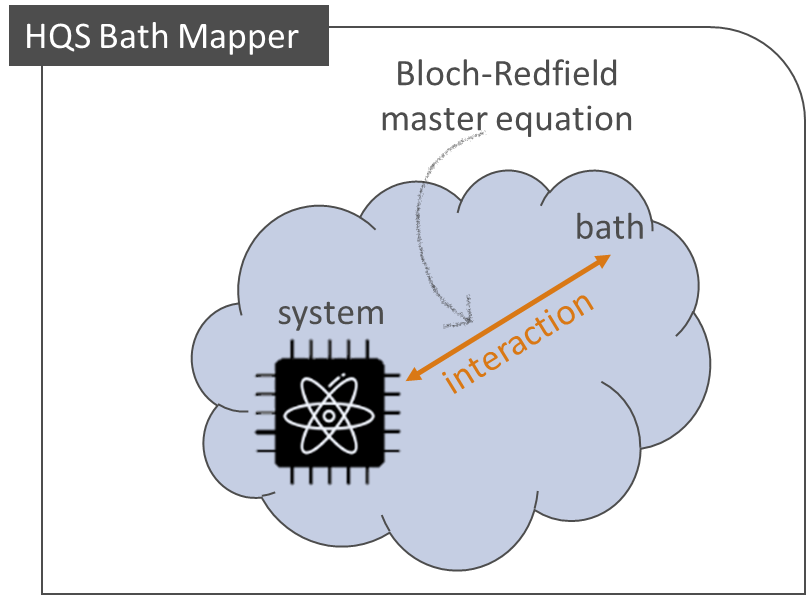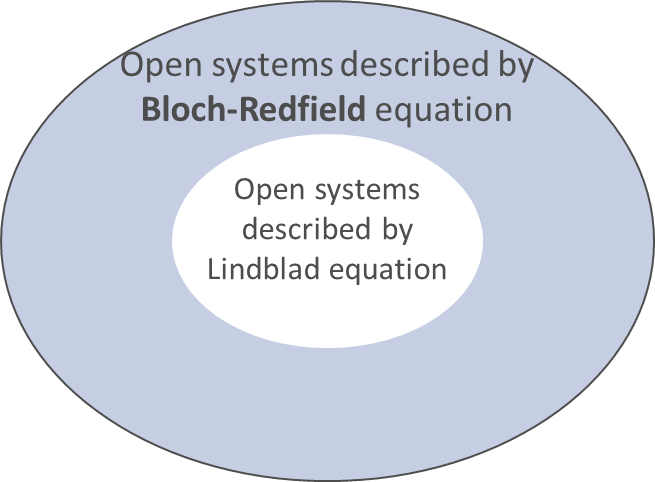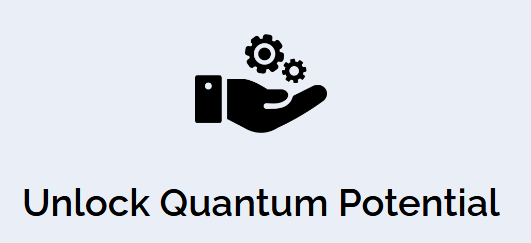Introduction
The Bath Mapper is a module that can be used in conjunction with other Quantum Libraries by HQS Quantum Simulations GmbH. It supports the user in creating quantum mechanical objects which utilize the Bloch-Redfield master equation. This equation is a mathematical model, here used in quantum computing, to describe the dynamics of open quantum systems interacting with their environment (or "bath"). The Bath Mapper also provides functionality to allow further processing of the created objects.

The Bloch-Redfield master equation is more general than the well-known Lindblad master equation. In particular, the Bloch-Redfield master equation does not make the assumption that the bath is Markovian, which allows the user to study open quantum systems as found in nature. The interactions of the system with the environment must be described by the spectral function, and the changes in the bath must be taken into account, making the computation more complex. What makes the HQS Bath Mapper so interesting, is that it explicitly uses the Bloch-Redfield master equation.

The user may find it hard to find a unified formulation of the Bloch-Redfield equation in textbooks, which is why we also provide the explicit form of it used in the HQS Bath Mapper here.
Applications
The main benefit of using the Bloch-Redfield equation instead of the Lindblad equation is that the user can study systems that are more likely to be found in nature. However, this approach is more specialized, which is why HQS provides the Bath Mapper module in addition to its struqture library. The Bath Mapper allows you to model more intricate interactions with the bath and more characteristics of the bath, by using the spectral function to represent the bath.
As mentioned above, another intrinsic advantage is that the user can study non-Markovian processes where the future quantum state depends on the past state and not only on the present state, which closely resembles real-world systems.

Here are some potential advantages and use cases of the Bath Mapper:
-
Modeling Open Quantum Systems: to study and understand real-world quantum systems, as they are rarely isolated and often interact with their environment.
-
Design and Optimization: since the Bath Mapper allows the user to manipulate the created objects, they can explore different settings and parameters.
-
Research and Development: using the Bath Mapper, researchers can model and manipulate quantum systems based on the Bloch-Redfield master equations to test hypotheses and explore new ideas.
-
Educational Purposes: as long as the access to the quantum computing hardware is a limited resource, such a tool can also be beneficial for educational purposes, helping students understand the underlying dynamics of open quantum systems.
The Bath Mapper can be used to create and manipulate objects based on the Bloch-Redfield master equation. The background physics associated with this is described in detail on the corresponding page.
Getting started
Install the package with the following command
hqstage install bath-mapper-py
The Bath Mapper is a module that can be used in conjunction with other HQS Quantum Libraries by HQS Quantum Simulations GmbH.
Please note that the HQS Quantum Libraries are currently only supported on Linux and MacOS.
Example implementations of the Bath Mapper functionality can be found here.
Features
The HQS Bath Mapper needs to be used in conjunction with the open-source HQS library struqture, designed for representing Hamiltonians and physical models. These objects are used as inputs and outputs for all of the functions below.
The functionalities associated with the SpinBRNoiseOperator and FermionBRNoiseOperators of the Bath Mapper are:
-
calculate_excitation_spectral_function: This function determines the bath excitation spectral function from a given Hamiltonian. Why it’s useful: The spectral function provides important information about how the environment (or “bath”) interacts with the user's quantum system. Understanding this interaction is crucial for predicting system behavior and designing experiments. -
spectral_function_to_coupling: This function converts a spectral function into a Hamiltonian that corresponds to the physical coupling between the system and the bath, describing how the spin system or fermion system interacts with its bosonic environment. Why it’s useful: By converting the spectral function into a Hamiltonian that represents the physical coupling, the user can better manipulate the interaction between their quantum system and its environment. This is important for tasks such as controlling decoherence and optimizing system performance. -
coupling_to_spectral_function: This function converts a Hamiltonian representing a physical coupling (describing how a spin system or fermion system is coupled to a bath) into a spectral function. Why it’s useful: This conversion helps the user to analyze and visualize the interaction in a different form, making it easier to interpret and apply in various contexts, such as theoretical studies or practical implementations.
For more detailed information on how to use these functions, including examples and specific inputs, please refer to the comprehensive documentation available here.
The API documentation is made available below.
Implementation and representation
When using the Bath Mapper, the user can create two primary types of objects: SpinBRNoiseOperator and FermionBRNoiseOperator. These objects are crucial for understanding and modeling noise in quantum systems.
-
SpinBRNoiseOperator: is used to model noise in systems that involve spin particles, such as electrons or atomic nuclei. In the context of quantum computing spins are used to encode quantum information and can be represented by Pauli operators. Spin noise can affect the coherence and stability of quantum states, so accurate modeling of this noise is important for applications in quantum computing. -
FermionBRNoiseOperator: is used to model noise in fermionic systems. In the context of quantum computing, fermions are represented by occupational operators. Fermionic noise is relevant in many areas of quantum mechanics and condensed matter physics, including the study of superconductors and quantum dots.
By creating and manipulating these objects the user can gain insight into how noise impacts their quantum system and develop strategies to mitigate its effects. For more detailed information on how to use these objects, including their specific methods and properties, please refer to the comprehensive documentation for spins and fermionic operators.
Further reading
The underlying principles of the HQS Bath Mapper are detailed in our [scientific paper]((https://arxiv.org/pdf/2210.12138), which presents a quantum algorithm for simulating open system dynamics on quantum computers by leveraging noise. An overview of bath mapping, i.e., mapping between an open-system model and a noisy-algorithm model, is given in the figure below, with more details to be found in the scientific paper.
